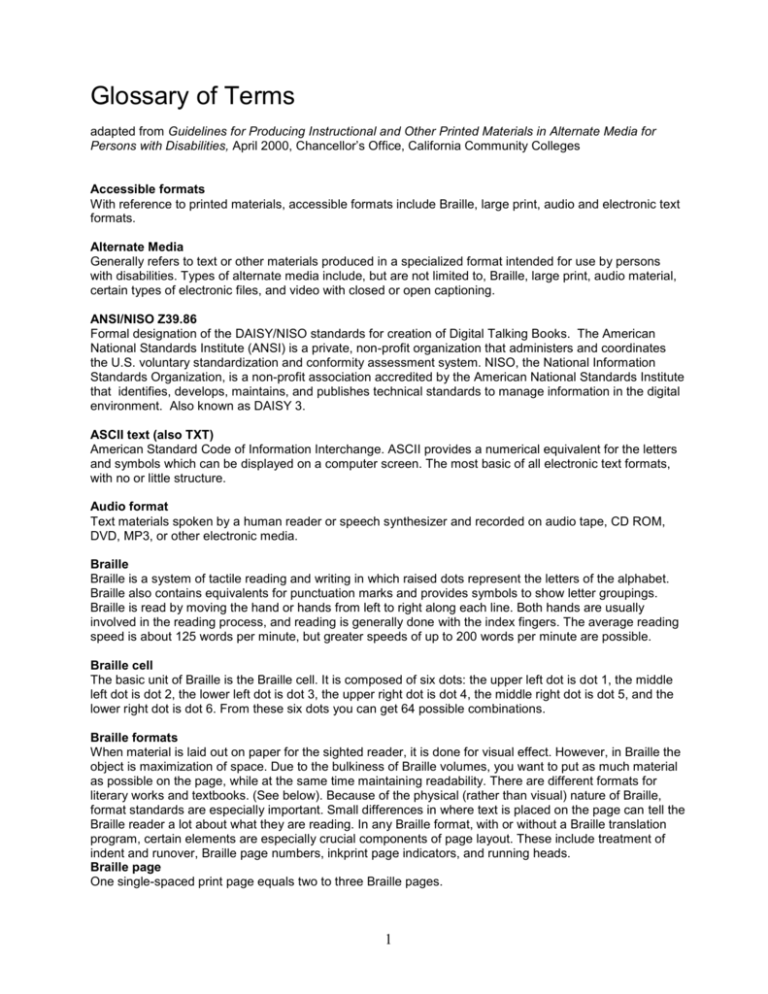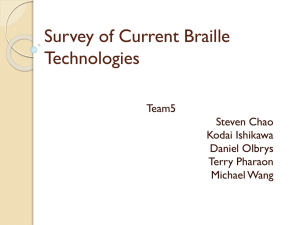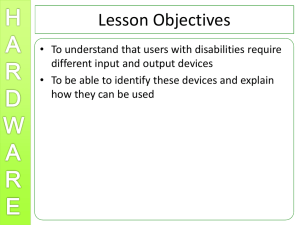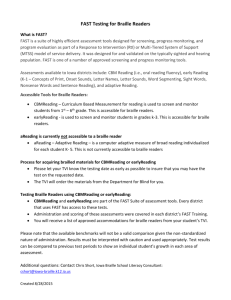Glossary of Terms
advertisement

Glossary of Terms adapted from Guidelines for Producing Instructional and Other Printed Materials in Alternate Media for Persons with Disabilities, April 2000, Chancellor’s Office, California Community Colleges Accessible formats With reference to printed materials, accessible formats include Braille, large print, audio and electronic text formats. Alternate Media Generally refers to text or other materials produced in a specialized format intended for use by persons with disabilities. Types of alternate media include, but are not limited to, Braille, large print, audio material, certain types of electronic files, and video with closed or open captioning. ANSI/NISO Z39.86 Formal designation of the DAISY/NISO standards for creation of Digital Talking Books. The American National Standards Institute (ANSI) is a private, non-profit organization that administers and coordinates the U.S. voluntary standardization and conformity assessment system. NISO, the National Information Standards Organization, is a non-profit association accredited by the American National Standards Institute that identifies, develops, maintains, and publishes technical standards to manage information in the digital environment. Also known as DAISY 3. ASCII text (also TXT) American Standard Code of Information Interchange. ASCII provides a numerical equivalent for the letters and symbols which can be displayed on a computer screen. The most basic of all electronic text formats, with no or little structure. Audio format Text materials spoken by a human reader or speech synthesizer and recorded on audio tape, CD ROM, DVD, MP3, or other electronic media. Braille Braille is a system of tactile reading and writing in which raised dots represent the letters of the alphabet. Braille also contains equivalents for punctuation marks and provides symbols to show letter groupings. Braille is read by moving the hand or hands from left to right along each line. Both hands are usually involved in the reading process, and reading is generally done with the index fingers. The average reading speed is about 125 words per minute, but greater speeds of up to 200 words per minute are possible. Braille cell The basic unit of Braille is the Braille cell. It is composed of six dots: the upper left dot is dot 1, the middle left dot is dot 2, the lower left dot is dot 3, the upper right dot is dot 4, the middle right dot is dot 5, and the lower right dot is dot 6. From these six dots you can get 64 possible combinations. Braille formats When material is laid out on paper for the sighted reader, it is done for visual effect. However, in Braille the object is maximization of space. Due to the bulkiness of Braille volumes, you want to put as much material as possible on the page, while at the same time maintaining readability. There are different formats for literary works and textbooks. (See below). Because of the physical (rather than visual) nature of Braille, format standards are especially important. Small differences in where text is placed on the page can tell the Braille reader a lot about what they are reading. In any Braille format, with or without a Braille translation program, certain elements are especially crucial components of page layout. These include treatment of indent and runover, Braille page numbers, inkprint page indicators, and running heads. Braille page One single-spaced print page equals two to three Braille pages. 1 Braille printers Also called embossers. The devices used to produce hard copy Braille. Braille production The process of translating, proofing, formatting and printing Braille documents. Braille translation The process of translating inkprint or electronic documents into Grade II, Nemeth Code or other forms of Braille. Braille translation software Specialized software capable of accurately translating text into Grade II Braille and preserving simple page formatting. CCTV Television equipment used by persons with low vision to magnify inkprint and other text materials for more convenient viewing, usually of desktop size. CD-ROM Compact Disk - Read Only Media. CD and DVD (Digital Versatile Disk) media are high capacity storage formats which can be used to save and retrieve text, audio and video information. Convert the file Generally refers to converting a file from one format to another (i.e. PageMaker to Microsoft Word). DAISY (Digital Accessible Information System) Set of open standards for creation of Digital Talking Books. Digital Talking Book (DTB) A navigable multimedia representation of a print publication, meeting a set of DAISY structure guidelines. Dot The smallest element of a Braille cell. Download To copy the contents of an electronic file from one location to another. Possibly across the Internet, from one location to another on a campus network or to removable media. Duplex Scanning The process of scanning two sides of a document with a single feed. Electronic text Text in MS Word, ASCII or other proprietary format. Also called “e-text”. Electronic versions of instructional materials Textbooks, tests, catalogs or other materials stored on floppy, zip, CD ROM, DVD or other storage media. Exact or similar in appearance to inkprint versions of the same material. Elements Generally refers to page formatting elements such as headings, subheadings, headers, footers, sidebars and marginalia of various types. File format The unique public or proprietary file storage format in which a document has been saved. 2 Formatting E-text Generally refers to the process of preserving the page location or text content of titles, paragraphs, columns, sidebars, footnotes, headers, footers, graphics, etc when scanning pages or moving documents between file formats. Grade 2 Braille To reduce the bulkiness of Braille there is a system of Braille contractions, or abbreviations known as Grade 2 Braille. For general text production, materials should be provided in Grade 2 Braille. Grade 2 Braille is the format most commonly used by persons who are blind. Graphics Usually refers to charts, drawings, photographs, animated objects, or digital video. Hardcopy Text printed on paper. Highspeed Scanner A scanner that has the ability of scanning large amounts of documents very quickly. HTM/HTML (Hypertext Markup Language Document) A web based document that is generally opened by a web browser. Files contain various level of markup/tags identifying structural elements. Instructional material A general term referring to textbooks, multimedia, tests, forms, class handouts or other materials written and published primarily for use by students in postsecondary instruction. KES (Kurzweil Document) Graphic files with text behind. They can be read by Kurzweil software only. Large Print Inkprint or electronic text displayed at a size greater than or equal to 14 point. MP3 (Motion Picture Experts Group-Layer 3) Audio compression format that creates near-CD-quality files that are 10 to 20 times smaller than music files on standard CDs. These can be heard on computers, MP3 players, and certain MP3 ready CD players. Nemeth Code Letters in the Nemeth Code are those of standard Braille, but nearly every other cell has a different meaning than in standard English Braille. Nemeth numbers for the digits 1-9, 0 are the letters a-i, j except that they are dropped one row. This number definition is possible because the letters a-j are all upper cells. In SEB most of these dropped cells are punctuation marks, so a blind person learning math must learn to interpret dropped cells as punctuation marks when reading text and as numbers when reading math. NIMAS (National Instructional Materials Accessibility Standard) Standards to guide the production and electronic distribution of digital versions of textbooks and other instructional materials so they can be more easily converted to accessible formats, including Braille and text-to-speech. Version 1.0 of the NIMAS standard was developed in 2002-2004 by the National File Format Technical Panel comprised of 40 technology specialists, educators, disability advocates, and publishers and is based on the ANSI/NISO Z39.86 (DAISY 3) specification. OCR (Optical Character Recognition) A program that “reads” text from graphic images and translates the images into manipulatible text. Page layout The arrangement of text and graphics on an inkprint or electronic page. 3 PDF (Portable Document Format) The file format for documents viewed and created by Adobe Acrobat Reader, Acrobat Capture, Adobe Distiller, Adobe Exchange, and the Adobe Acrobat Amber plugin. Some PDF files are graphic only and others have text behind. Proofread Within the context of alternate media, proofreading might mean, in addition to checking for errors in spelling, correcting page formatting errors, formatting Braille documents so they maintain critical content design elements, or listening to the audio content of a recorded book to assure that it remains faithful to the inkprint version. Proprietary formats Refers to text formatting, storage and retrieval methods often used by textbook publishers and printers. Examples include Quark Express, FrameMaker, PageMaker and PDF. Refreshable Braille display When used in conjunction with screen reading software, these devices provide the text content of a document, web page or other information displayed on the computer screen in “real-time” Braille. RFB&D Recording for the Blind & Dyslexic was founded in 1948 to help blind and disabled veterans take full advantage of the GI Bill educational benefits. RFB&D is a volunteer organization whose sole purpose is to provide educational materials in recorded and computerized formats at every academic level. RFB&D materials are for all people unable to read standard print because of a visual, perceptual, or other physical disability. RTF RTF (Rich Text Format) is a text file format that lets you exchange text files between different word processors in different operating systems. Scanning The process of imaging printed pages with a desktop or commercial scanner, using optical character recognition software to convert the scanned pages to text, correcting text misrecognition errors and reformatting as necessary to preserve the structural integrity of the document. Screen reading software Software used by persons who are blind or have learning disabilities to verbalize the text contents of the computer screen. Many screen reading programs are highly sophisticated and capable of reading very complex page formats and web pages. Simplex scanning The process of scanning one side of a document with a single feed. Specialized formats See proprietary formats. Speech synthesis software Software used with a computer’s sound card to reproduce near-human sounding speech. Speech synthesizer Hardware/software used by speech synthesis software to produce near human sounding speech. Structural integrity Structural integrity’ means all of the printed instructional material, including, but not limited to, the text of the material, sidebars, the table of contents, chapter headings and subheadings, footnotes, indexes, glossaries, and bibliographies. ‘Structural integrity’ need not include nontextual elements such as pictures, illustrations, graphs, or charts. 4 Tables A text formatting protocol used to arrange information in rows and columns. Tactile graphics Graphic images produced as raised images. Such raised images may be produced by a device using heat and heat-sensitive paper. This enables high quality tactile graphics, suitable for blind and visually impaired people, to be made quickly and easily. Some tactile graphics can also be produced using a Braille embosser. Tapes Refers to audio tapes of books or other materials read aloud by a human reader or by a speech synthesizer. Text Reader Software capable of reading text material aloud on a computer screen. Unlike a screen reader, only the imported text material is read, not every text element showing on the screen. Textbook format The format used for producing textbooks in Braille. The major difference between Braille textbook and Braille literary formats in the main body of text is inkprint page indicators. Textbook format has them; literary format doesn’t. For textbook format with no running head, text appears on every line. TIFF (Tagged Image File Format) A graphic file format developed by Aldus and Microsoft. These are used for still-images, often the initial product from scanning hard copy. They are not readable by screen readers. Transcription To move the content of a document from one format to another as in transcribing the content of audio tape to text or from print to Braille. WAV Digital audio (wave format) files that can be heard on any CD player or computer. They are very large files; while three novels may fit on one CD in MP3 format, one of those three novels may take 20 or more CD’s in WAV format. Web Pages Documents formatted in one of several page layout or “mark up” languages including html, dhtml and xml. Word processing formats Refers to public and proprietary software systems used for embedding non-ASCII characters into a document for the purpose of formatting the appearance of information on the computer screen. Examples of word processing formats include Microsoft Word and WordPerfect. XML (eXtensible Markup Language Document) A simple, very flexible text format containing various level of markup/tags identifying structural elements. Originally designed to meet the challenges of large-scale electronic publishing, XML is also playing an increasingly important role in the exchange of a wide variety of data on the Web and elsewhere. Zip files Zip files are “archives” used for distributing and storing files. Zip files contain one or more files. Usually the files “archived” in a Zip are compressed to save space. Zip files make it easy to group files and make transporting and copying these files faster. 5





